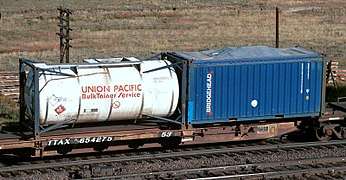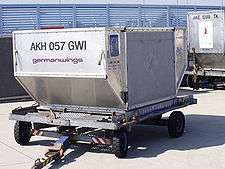Shipping container
A shipping container is a container with strength suitable to withstand shipment, storage, and handling. Shipping containers range from large reusable steel boxes used for intermodal shipments to the ubiquitous corrugated boxes. In the context of international shipping trade, "container" or "shipping container" is virtually synonymous with "intermodal freight container," a container designed to be moved from one mode of transport to another without unloading and reloading.[1]

Types
Intermodal freight containers

Freight containers are a reusable transport and storage unit for moving products and raw materials between locations or countries.[2] There are about seventeen million intermodal containers in the world, and a large proportion of the world's long-distance freight generated by international trade is transported in shipping containers. In addition, it is estimated that several million of these containers have now been discarded due to the shipping cost of sending them back to their port of origin. Their invention made a major contribution to the globalization of commerce in the second half of the 20th century, dramatically reducing the cost of transporting goods and hence of long-distance trade.[3][4]
Specialized shipping containers include: high cube containers (providing an extra 1 ft (305 mm) in height to standard shipping containers), pallet wides, open tops, side loaders, double door or tunnel-tainers, and temperature controlled containers. Another specialized container, known as Transtainer, is a portable fuel and oil freight container. The hybrid bulk fuel tank is originally intended for the construction, mining, logging and farming sectors. The tank can be used to transport and store bulk fuels as well as dangerous liquids, by road, rail and sea.[5]
Corrugated box
Corrugated boxes are commonly used as shipping containers[6] (more than 90% of all shipping containers are of this type).[6][7] They are made of corrugated fiberboard which is lightweight, recyclable, and strong enough to ship a variety of products.
Wooden box
Wooden boxes are often used for shipping heavy and dense products. They are sometimes specified for shipments of government or military shipments.
Crate
A crate is a large container, often made of wood, used to transport large, heavy or awkward items. A crate has a self-supporting structure, with or without sheathing.
Reusable plastic versions include:
- Euro container
- Systainer, for shipping tools.
Intermediate bulk shipping container

An intermediate bulk container (IBC, IBC Tote, IBC Tank) is a multi-use container employed for the general transport, storage, and handling of bulk fluids and materials. IBC tanks are compatible with, and resistant to, an extensive list of chemicals, acids, caustics, as well as inert materials and food grade consumables. IBCs are commonly manufactured from the following materials:
- Plastic (High-Density Polyethylene)
- Composite: Steel & Plastic
- Carbon Steel
- Stainless Steel (304 & 316/316L SS grades)
Some IBC engineering models are foldable (collapsible) for space-saving breakdown following use.
Flexible intermediate bulk container
A Flexible intermediate bulk container, FIBC, big bag, bulk bag, or super sack is a standardized container in large dimensions for storing and transporting and storing granular products. It is often made of a woven synthetic material.
Bulk box
A bulk box, bulk bin, skid box, or tote box is a pallet size box used for storage and shipping of bulk quantities.
Drum
.jpg)
Drums are cylindrical shipping containers made of steel, plastic or fiber. They are often used for liquids and granular materials.
Insulated
Insulated shipping containers are a type of packaging used to ship temperature sensitive products such as foods, pharmaceuticals, and chemicals. They are used as part of a cold chain to help maintain product freshness and efficacy.
Pail
Some pails are used as shipping containers.[8]
Unit load device

A Unit Load Device, or ULD, is a container used to transport cargo on commercial aircraft.
A ULD can be a pallet or container used to load luggage, freight, and mail on wide-body aircraft and specific narrow-body aircraft. It allows a large quantity of cargo to be bundled into a single unit. Since this leads to fewer units to load, it saves ground crews time and effort and helps prevent delayed flights. Each ULD has its own packing list, manifest, or tracking identification to improve control and tracking of contents
Specialized
.jpg)
Custom containers are used for shipments of products such as scientific instruments, weapons and aviation components.[9] Customized cushioning, blocking and bracing, carrying handles, lift rings, locks, etc. are common to facilitate handling and to protect the contents. Often, these shipping containers are reusable.
The reusable ifco tray ("international fruit container") is used in Europe for transportation of fruit, vegetables, and fish.
Transit and flight cases
Flight cases and transit cases are usually custom designed for shipping and carrying fragile equipment: audio visual, camera, instruments, etc. Although generally light in construction, they tend to have reinforced edges and corners.
Road cases
Road cases are often used for shipping musical instruments and theater props.
Re-use

The widespread availability and relative cheapness of used intermodal shipping containers meant that architects began to consider them as an alternative to traditional building materials.[10] Used shipping containers have been converted for use in housing, and as retail and office spaces.[11][12] Examples of its use include the Cité A Docks student housing project in Le Havre, France;[13] the Wenckehof container village in Amsterdam;[14] the portable Puma City store in US cities;[15][16] the food and retail Boxpark in London;[17] the Dordoy Bazaar in Bishkek, Kyrgyzstan;[18] the temporary mall Re:START in Christchurch, New Zealand built after the 2011 Christchurch earthquake,[19] and as intensive-care units in temporary hospitals during the COVID-19 pandemic.[20]
It has however been pointed out there are problems with recycling shipping containers, that it may not be as ecologically friendly or cheap an option as it might appear. The containers may be coated with harmful chemicals such as chromate, phosphorus, and lead-based paints, while its wooden floors may be treated with toxic insecticides, and some cost and effort are involved in modifying containers to make them habitable.[10] Others have noted various issues such as space constraint, insulation, and structural weakness if too much steel is cut out of the containers.[21][22]
Shipping containers are used in the film and television industry for building temporary sets. Shipping containers can be stacked on top of each other and used as reinforced scaffold that large-scale film sets can be built against. An example can be seen at Leavesden Studios, England; an area of the studio backlot is allocated to spare containers when not in use.
See also
- Containerization
- Container garden
- Dumpster
- Fumigation
- Intermodal container
- Logistics
- Nuclear flask
- NYC container
- Packaging
- Pallet
- Roll trailer
- Sidelifter - Specialized vehicle for shipping containers.
- Skip (container)
- Spent nuclear fuel shipping cask
References
- Dictionary of International Trade: "Container: ... must be b) specially designed to facilitate the carriage of goods by one or more modes of transport without intermediate reloading. ... Ocean shipping containers are generally 10, 20, 30, or 40 feet long ... and conform to ISO standards"
- "Shipping Tip – Container Shipping Limitations | CFR Rinkens". CFR Rinkens. 2017-02-16. Retrieved 2018-05-31.
- Levinson, Marc. "Sample Chapter for Levinson, M.: The Box: How the Shipping Container Made the World Smaller and the World Economy Bigger". The Box: How the Shipping Container Made the World Smaller and the World Economy Bigger. Princeton University Press. Archived from the original on 22 January 2013. Retrieved 17 February 2013.
- Gittins, Ross. "How the invention of a box changed our world – Business – smh.com.au". The Sydney Morning Herald. Retrieved 17 February 2013.
- Portable fuel, oil freight container
- Dennis, William T. (December 2011). Parcel and Small Package Delivery Industry. William Dennis. ISBN 9781461021544.
- Pahl, Greg (2000-12-01). The Complete Idiot's Guide to Saving the Environment. Penguin. ISBN 9780028639826.
- Uniform Freight Classification: Ratings, Rules and Regulations Applicable to Freight Traffic Covered by Tariffs Governed by the Uniform Freight Classification, as Such Tariffs May Specify. 1961.
- MIL-STD-648D, DEPARTMENT OF DEFENSE DESIGN CRITERIA STANDARD, SPECIALIZED SHIPPING CONTAINERS (PDF), 10 April 2008, retrieved 26 April 2018
- Pagnotta, Brian (29 August 2011). "The Pros and Cons of Cargo Container Architecture". Arch Daily.
- Morgen Bromell, Evelyn Lee, Maria Cohn (13 March 2013). "The 25 Coolest Structures Made From Shipping Containers". Complex.CS1 maint: uses authors parameter (link)
- Riley, Tess. "Shipping container architecture – in pictures". The Guardian.
- "Cité A Docks Student Housing by Cattani Architects". Contemporist. September 30, 2010.
- Forrest, Adam (9 October 2015). "Living in a steel box: are shipping containers really the future of housing?". The Guardian.
- LOT-EK. UPCYCLE. p. 20. ISBN 9781105967931.
- Yuka Yoneda. "Puma City Shipping Container Store Comes to Boston's Fan Pier". Inhabitat.
- Fry, Simon (26 January 2017). "Boxing clever: The firms based in shipping containers". BBC.
- Sershen, Daniel (4 January 2007). "'Made in China' moves into Russia's backyard". Christian Science Monitor.
- Martin Van Beynen (19 October 2011). "Christchurch pop-up mall may be world first". stuff. Fairfax Media.
- Wainwright, Oliver (27 March 2020). "Architect in Italy turns shipping containers into hospitals for treating Covid-19". The Guardian.
- Alter, Lloyd (28 June 2016). "Shipping container pavilion lets it all hang out". Treehugger.
- "5 Mistakes To Avoid When Building A Shipping Container Home". Container Home Plan.
External links
| Wikimedia Commons has media related to Shipping containers. |
- ASTM Shipping Container Standards and Related Technical Material, 5th edition, 2007, ASTM
- McKinlay, A. H., "Transport Packaging", Institute of Packaging Professionals, 2004
- Yam, K.L., "Encyclopedia of Packaging Technology", John Wiley & Sons, 2009, ISBN 978-0-470-08704-6